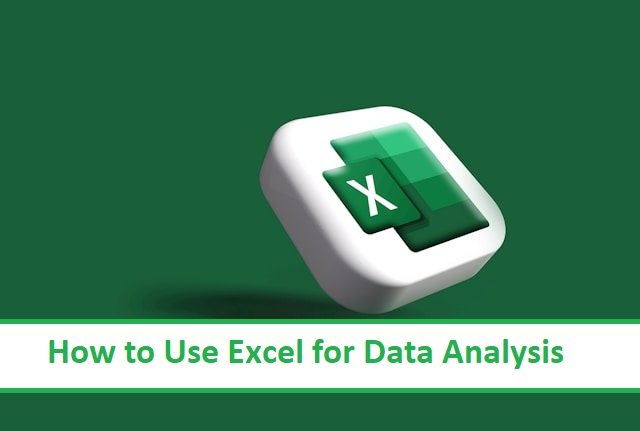
Microsoft Excel is a powerful tool for data analysis. Its wide range of functions and features makes it suitable for analyzing small to moderately large datasets. This guide will walk you through the essential steps and techniques to leverage Excel for effective data analysis.
1. Preparing Your Data

Before diving into analysis, ensure your data is clean and well-organized. Here are some key steps:
1.1 Importing Data
- CSV/TSV Files: Use the “Get Data” feature in Excel to import data from CSV/TSV files.
- Databases: Excel can connect to databases like SQL Server, Access, and others via ODBC connections.
- Other Sources: Data can also be imported from web pages, text files, and other Excel workbooks.
1.2 Cleaning Data
- Remove Duplicates: Use the “Remove Duplicates” feature under the Data tab to eliminate duplicate entries.
- Handle Missing Data: Identify and handle missing values by removing rows, filling with mean/median, or using advanced techniques like interpolation.
- Standardize Data: Ensure consistent data formats, e.g., date formats, text cases, and numeric precision.
2. Basic Data Analysis Techniques

2.1 Sorting and Filtering
- Sort Data: Organize data in ascending or descending order based on one or multiple columns.
- Filter Data: Use filters to display only the data that meets certain criteria.
2.2 Using Formulas and Functions
- Basic Functions: Use SUM, AVERAGE, COUNT, MIN, and MAX to perform basic calculations.
- Conditional Functions: Use IF, COUNTIF, SUMIF, and AVERAGEIF for conditional analysis.
- Text Functions: Use CONCATENATE, LEFT, RIGHT, MID, FIND, and LEN for text manipulation.
- Date Functions: Use TODAY, NOW, DATE, YEAR, MONTH, DAY, and NETWORKDAYS for date calculations.
3. Data Visualization

3.1 Creating Charts
- Bar and Column Charts: Ideal for comparing categories.
- Line Charts: Great for showing trends over time.
- Pie Charts: Useful for displaying proportions.
- Scatter Plots: Used to show the relationship between two variables.
3.2 PivotTables and PivotCharts
- PivotTables: Summarize large datasets with drag-and-drop functionality.
- PivotCharts: Visual representation of PivotTable data for easier interpretation.
4. Advanced Data Analysis Techniques

4.1 Data Analysis ToolPak
Excel’s Data Analysis ToolPak provides various advanced tools:
- Descriptive Statistics: Summary statistics including mean, median, mode, and standard deviation.
- Regression Analysis: Understand relationships between variables.
- ANOVA: Analyze the differences among group means.
4.2 Solver
Solver is an Excel add-in that performs optimization analysis. It finds the best solution for a problem by changing multiple variables.
4.3 Scenario Manager
Scenario Manager allows you to create and analyze different scenarios (sets of values) and see their impact on your data.
5. Tips and Best Practices

- Use Named Ranges: Make formulas easier to read and manage by using named ranges.
- Freeze Panes: Keep headers visible while scrolling through large datasets.
- Conditional Formatting: Highlight important data points with color-coding.
- Use Tables: Convert ranges to tables for easier data manipulation and automatic formula updates.
6. Case Study: Analyzing Sales Data

Let’s apply what we’ve learned to a sample sales dataset.
6.1 Importing and Cleaning Data
- Import Data: Import the sales data from a CSV file.
- Clean Data: Remove duplicates, handle missing values, and standardize formats.
6.2 Basic Analysis
- Sort and Filter: Sort the data by sales amount and filter to show top-performing products.
- Basic Calculations: Calculate total sales, average sales per region, and count of sales transactions.
6.3 Visualization
- Create Charts: Generate a bar chart showing sales by region and a line chart showing sales trends over time.
- PivotTable: Create a PivotTable to summarize sales by product and region.
6.4 Advanced Analysis
- Regression Analysis: Perform regression analysis to understand the impact of marketing spend on sales.
- Scenario Analysis: Use Scenario Manager to evaluate different marketing budget scenarios.
Frequently Asked Questions (FAQs)
1. What are the basic requirements for performing data analysis in Excel?
- Excel Software: Ensure you have a recent version of Microsoft Excel installed.
- Data: Have your data ready in a compatible format like CSV, TSV, or an Excel workbook.
- Basic Excel Knowledge: Familiarity with Excel’s interface and basic functions.
2. How do I import data into Excel?
- CSV/TSV Files: Go to Data > Get Data > From File > From Text/CSV, then select your file.
- Databases: Use Data > Get Data > From Database and choose your database type.
- Web Pages: Use Data > Get Data > From Web and enter the URL of the webpage.
3. What are the common data cleaning techniques in Excel?
- Remove Duplicates: Use Data > Remove Duplicates.
- Handle Missing Data: Use Find & Select > Go To Special > Blanks and decide how to handle missing values.
- Text to Columns: Use Data > Text to Columns for splitting text into separate columns.
4. How do I use formulas for basic data analysis?
- SUM: =SUM(range)
- AVERAGE: =AVERAGE(range)
- COUNT: =COUNT(range)
- MIN/MAX: =MIN(range) or =MAX(range)
5. How can I visualize my data in Excel?
- Charts: Go to Insert > Charts and select the chart type (e.g., bar, line, pie).
- PivotCharts: Create a PivotTable first, then use PivotTable Tools > Analyze > PivotChart.
6. What are PivotTables and how do I use them?
- Creating a PivotTable: Select your data, then go to Insert > PivotTable. Choose where you want the PivotTable to be placed and click OK.
- Using PivotTables: Drag and drop fields into the Rows, Columns, Values, and Filters areas to summarize your data.
7. What advanced data analysis tools are available in Excel?
- Data Analysis ToolPak: Enable it via File > Options > Add-ins > Analysis ToolPak.
- Solver: Add it via File > Options > Add-ins > Solver Add-in.
- Scenario Manager: Access it via Data > What-If Analysis > Scenario Manager.
8. How do I perform regression analysis in Excel?
- Enable Data Analysis ToolPak: Ensure the ToolPak is enabled.
- Run Regression: Go to Data > Data Analysis > Regression, select your input Y range (dependent variable) and input X range (independent variables), then click OK.
9. How can I automate data analysis in Excel?
- Macros: Record macros via View > Macros > Record Macro to automate repetitive tasks.
- VBA (Visual Basic for Applications): Write VBA scripts for more complex automation.
10. What are some tips for effective data analysis in Excel?
- Use Named Ranges: Define named ranges for better formula readability.
- Freeze Panes: Use View > Freeze Panes to keep headers visible while scrolling.
- Conditional Formatting: Highlight key data points using Home > Conditional Formatting.
- Tables: Convert data ranges to tables via Insert > Table for easier data manipulation.
11. How can I ensure my Excel data analysis is accurate?
- Double-Check Formulas: Verify that all formulas are correct and referencing the right cells.
- Cross-Reference with Source Data: Compare results with the original data to ensure consistency.
- Use Error-Checking Tools: Utilize Excel’s error-checking features to identify and correct mistakes.
12. Can Excel handle large datasets?
- Performance Tips: For large datasets, use Excel’s features like PivotTables and Power Query. Consider using PowerPivot for enhanced data modeling capabilities.
- Limitations: Excel has row and column limitations (1,048,576 rows and 16,384 columns in recent versions). For extremely large datasets, consider using database tools like SQL or software like R or Python.
Conclusion
Excel is a versatile and powerful tool for data analysis. By mastering its features and functions, you can perform a wide range of analyses, from basic calculations to advanced statistical modeling. With practice and the right approach, you can transform raw data into valuable insights using Excel. Feel free to adjust or expand upon this guide to suit specific needs or to include additional examples and detailed steps.




